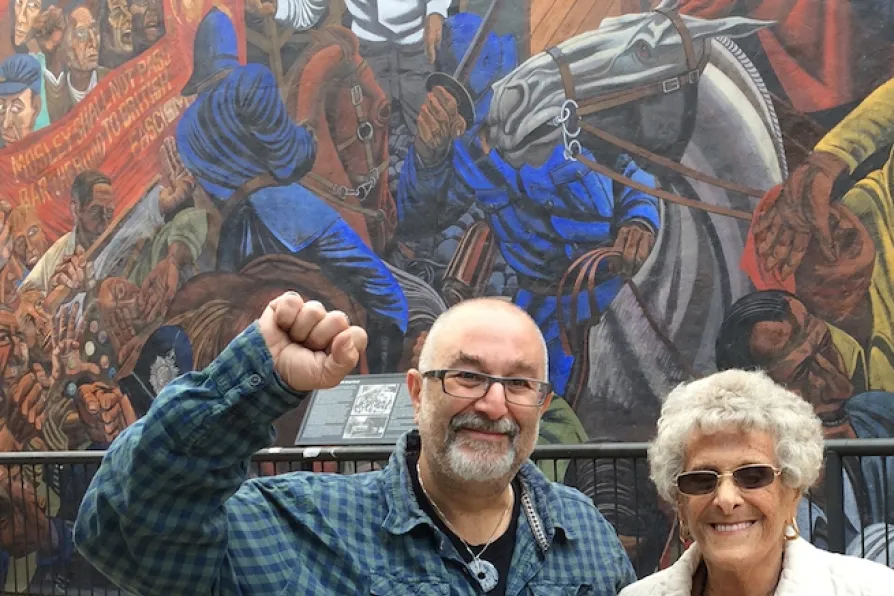The Labour leadership’s narrow definition of ‘working people’ leads to distorted and unjust Budget calculations, where the unearned income of the super-wealthy doesn’t factor in at all, argues JON TRICKETT MP
On the anniversary of the Battle of Cable Street, DAVID ROSENBERG reflects on his encounters with those who were there that day in 1936 – and suggests two urgent tasks for the anti-fascists of today

 David Rosenberg with the late Beatty Orwell, in front of the Cable Street mural. Photo: Author Supplied
David Rosenberg with the late Beatty Orwell, in front of the Cable Street mural. Photo: Author Supplied
I CAN’T recall when I first heard of “Cable Street” but as a child I remember my grandfather, Syd, formerly an East End amateur boxer, boasting about “Blackshirts” he had floored.
By my teens, when I first joined anti-fascist demonstrations, I was well aware of a huge event in 1936 when Oswald Mosley’s British Union of Fascists were stopped from invading the East End’s Jewish enclave by a mass counter-protest involving blockades and barricades.
In my early twenties I began to hear about it directly from activists who were there, such as Issy Pushkin, a key figure in the grassroots Jewish People’s Council (JPC) that took a 100,000-strong petition to the home secretary, demanding that he ban Mosley’s march. Hours after the home secretary rejected the petition, citing “free speech” and “free movement,” Mosley’s presumably, the JPC handed out leaflets calling on “Citizens of London” to make sure the fascist’s march would “not take place.”
In 1984, I shared a platform with Charlie Goodman, imprisoned for three months for his militancy that day. Charlie recounted with disgust the attitude of Mr Prince from the Jewish Discharged Prisoners Aid Society, who asked Charlie what had landed him in prison. When Charlie replied, “fighting fascism,” Prince berated him: “You are the kind of Jew who gives us a bad name.”
Later, we visited Charlie and his wife Joyce at their Bethnal Green flat. She had been with another girl in the anti-fascist blockade that day, both just 12 years old. Charlie was the first veteran of the international Brigades I met. Weeks after his prison release he was fighting Franco’s forces in Spain.
Mick Mindel, a former Communist Party member and tailoring union official whom I interviewed In 1986, said: “it was a marvellous day … such a feeling of achievement, of working-class unity … mind you, it wasn’t any of the Blackshirts we fought … it was the police!”
Post-millennium I spoke with Aubrey Morris, who, as a 16-year-old, helped build barricades in Cable Street. His grandmother ran the family’s beigel bakery at number 86. Aubrey did not want Blackshirts anywhere near that building! His strongest memory that day was dockers arriving en masse to reinforce Jewish people’s defences against the fascists.
I first met Max Levitas in 2011. He was a “runner” on October 4, relaying messages to direct crowds to key places. In 2016, aged 101, he was the last veteran to speak at our five-yearly commemorations of the Battle.
Earlier that year I interviewed three formidable women in their late eighties and nineties, witnesses and participants in October 1936. As a teen, Beatty Orwell was in a group that specialised in disrupting fascist events. She described once being surrounded by a group of Blackshirts, whose main bully got up close and spat “Go home, Jew.” She knew he didn’t mean to Aldgate. Beatty stared back at him and said, “I am home.” He backed off.
What struck me about each of these veterans was their pride at being involved in such a remarkable event and their lack of egotism. They were, as Aubrey Morris put it, “simply doing what any young Jewish person would have done.”
I have been helping to organise the commemorations since 2011, and look forward to next year’s 90th anniversary. But if we are going to develop the most effective responses to the frightening resurgence of the far right here in Britain in 2025, we need to discard myths and place Cable Street within a multi-layered history of how fascism was stopped then.
This was one day, one battle, albeit on an enormous scale. Its success reflected dedicated planning and preparation and extraordinary efforts to mobilise. But their work continued, with mass leafleting to defeat Mosley’s party in the East End’s local elections in March 1937, and housing campaigns against landlords through the Stepney Tenants’ Defence League in 1938 and ’39 which united the Irish and Jewish communities that Mosley tried to set against each other.
Fascism in 1930s Britain was defeated nationally. Its movement was disrupted, resisted and ultimately defeated in street battles and political campaigns over several years — in Stockton, Leeds, Manchester, Liverpool, Bristol … and in Cable Street, east London. They have the scars to prove it. But between each dramatic battle, fascism was being undermined in quieter ways through educating, arguing, persuading.
Our 1930s counterparts grasped that beyond hard-core, far-right ideologues, many angry, neglected, struggling people were attracted by Mosley’s promise to restore their pride. He offered them a flag and someone to hate in place of food, a secure job, and the housing they needed. Fascism has always been a project of the elite, exploiting those whose situation is deteriorating, who feel that no-one’s on their side.
Some anti-fascists still dream of stopping them in one huge city-centre conflagration, but ultimately this will be won politically in our localities.
Right now we have two urgent tasks: to defend all minorities who will pay with their blood as victims of race hate; and to expose the Robinsons and Farages to their own supporters, as self-centred grifters, groomers of capitalism’s victims, the ignored and hopeless. Some of those falling for far-right arguments are in our workplaces. We must spend more time talking to them and less time talking to each other in safe spaces. The clock’s ticking.
David Rosenberg is the author of Battle for the East End (2011); and Rebel Footprints (2nd edition, 2019).










